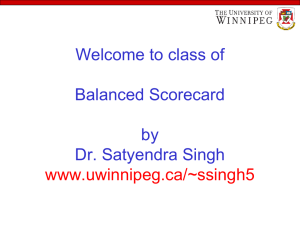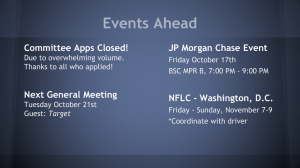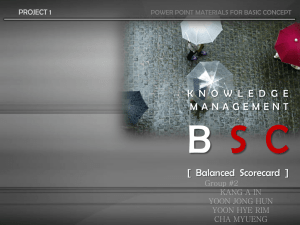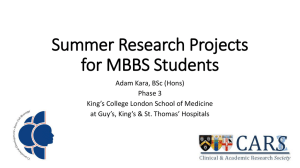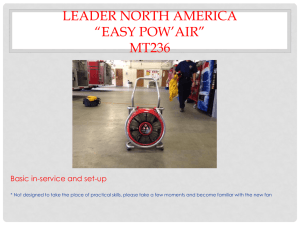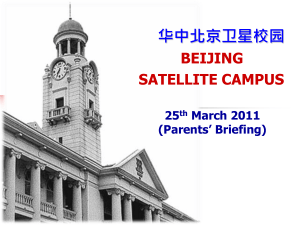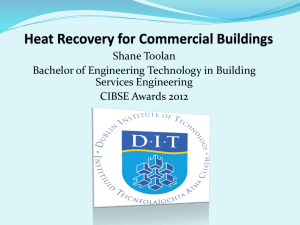Biological Safety Cabinet Basics
advertisement
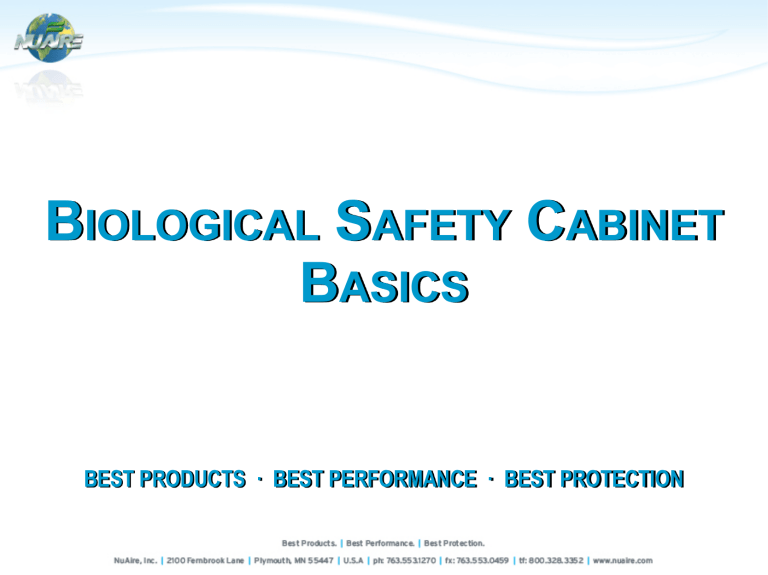
BIOLOGICAL SAFETY CABINET BASICS BEST PRODUCTS · BEST PERFORMANCE · BEST PROTECTION HORIZONTAL LAMINAR FLOW CLEAN ROOM VERTICAL LAMINAR FLOW CLEAN ROOM HORIZONTAL LAMINAR FLOW CLEAN WORK STATION VERTICAL LAMINAR FLOW WORK STATION BALANCED LAMINAR AIR FLOW HOOD NIH-03-112C CABINET (NATIONAL INSTITUTE OF HEALTH) Class II - Type A 10 inch - Inflow Supply 80 + 5 fpm 8 inch opening – Inflow Supply 90 + 5 fpm Downflow 80 + 5 fpm with a range of 64 to 96 fpm for all readings NCI-1 (NATIONAL CANCER INSTITUTE) Class II - Type B1 8 inch opening – Inflow Supply 100 + 10 fpm Downflow 50 + 5 fpm with a range of 45 to 60 fpm for all readings NSF-49 (NATIONAL SANITATION FOUNDATION) June 1976 Committee composed of: NIH NCI CDC Manufactures Users May 1993 changed from a construction specifications in favor of performance criteria HORIZONTAL LAMINAR FLOW CLEAN WORK BENCH (PRODUCT PROTECTION ONLY) Unit Components Unit Air flows Unit Types Bench Top Console Vertical NU-201 AIR FLOW NU-301 AIR FLOW CLASS I BIOLOGICAL SAFETY CABINET 100% Exhaust Inflow velocity 75 fpm minimum BSL 1 –3 Usage Personnel protection only CDC/NIH recommends a glove-port panel for use with small amounts of radionuclides when exhausted Typical uses today: Toxic powder weighing, necropsy Maybe thimble/air gap or hard connected to a exhaust system when proper precautions are taken Filtered Exhaust Air Room Air LabGard 813 Air Flow CLASS I AIR FLOW CLASS II – TYPE A1 30% Exhaust, 70% Re-circulate Negative pressure plenum (Changed 2007) Inflow velocity 75 fpm minimum BSL 1 –3 Usage Personnel and Product protection Minute amounts of non-volatile toxic chemicals and radionuclides if canopy/thimble exhausted Typical uses today: Bacterial, Viral, Fungal, Parasitic CLASS II – TYPE A1 70% Console Bench Top CLASS II – TYPE A2 30% Exhaust, 70% Re-circulate Negative pressure plenum Inflow velocity 100 fpm minimum BSL 1 –3 Usage Personnel and Product protection Minute amounts of volatile toxic chemicals and radionuclides if canopy/thimble exhausted Typical uses today: Bacterial, Viral, Fungal, Parasitic, Arbor-viruses CLASS II – TYPE A2 70% Console Bench Top CLASS II – TYPE B1 70% Exhaust, 30% Re-circulate Negative pressure plenum Inflow velocity 100 fpm minimum BSL 1 –3 Usage Personnel and Product protection Minute amounts of volatile toxic chemicals and radionuclides Must be hard connected with typical exhaust requirement being 300-500 CFM at 1.0” w.g. Must have interlocked internal blower with audible and visual alarm for exhaust failure Typical uses today: Bacterial, Viral, Fungal, Parasitic, Arbor-viruses CLASS II – TYPE B1 CLASS II – TYPE B2 100% Exhaust Negative pressure plenum Inflow velocity 100 fpm minimum BSL 1 –3 Usage Personnel and Product protection Small amounts of volatile toxic chemicals and radionuclides Must be hard connected with typical exhaust requirement being 700-1,200 CFM at 2.0” w.g. Must have interlocked internal blower with audible and visual alarm for exhaust failure Typical uses today: Bacterial, Viral, Fungal, Parasitic, Arbor-viruses, Prion, Cytotoxics CLASS II – TYPE B2 ONE-ON-ONE EXHAUST SYSTEM 10’ Above roof line Make-up Air Supply Stack Contactor Blower Damper (Automated or Manual) Cabinet GANGED EXHAUST SYSTEM Stack Make-up Air Supply Contactor Blower Duct CAV Ceiling Ceiling Damper (Manual) Cabinet CLASS III – “GLOVE BOX” 100% Exhaust Glove Box Negative Pressure at 0.5” w.g. minimum Double HEPA Filter Exhaust BSL 4 Personnel and Product Protection Small amounts of volatile toxic chemicals and radionuclides Must be hard connected with typical exhaust requirement being 50-100 CFM at 0.5 w.g. Must have negative pressure alarm for cabinet or exhaust failure Typical uses today: Toxic Powders, BSL 4 Agents BIOLOGICAL SAFETY CABINET CLASS / TYPES Class I: Personnel Protection Only 100% exhaust Inflow velocity 75 fpm minimum Class II: Personnel and Product Protection Type A1 - 30% exhaust, 70% re-circulate Negative Pressure Plenum (Changed 2008) Inflow velocity 75 fpm minimum Type A2 - 30% exhaust, 70% re-circulate Negative Pressure Plenum Inflow velocity 100 fpm minimum BIOLOGICAL SAFETY CABINET CLASS / TYPES Class II: Personnel and Product Protection Type B1 - 70% exhaust, 30% re-circulate Negative Pressure Plenum Inflow velocity 100 fpm minimum Type B2 - 100% exhaust Negative Pressure Plenum Inflow velocity 100 fpm minimum Class III: Personnel and Product Protection 100% exhaust Negative Pressure at 0.5” w.g. minimum RISK ASSESSMENT 1. 2. 3. 4. BSC CLASS BSL LEVEL OF AGENT USED NON-VOLITILE TOXIC CHEMICALS & RADIONUCLIDES VOLITILE TOXIC CHEMICALS & RADIONUCLIDES I I-3 YES YES (1, 3) II – TYPE A1 I-3 YES (1) NO II – TYPE A2 I-3 YES YES (4) II – TYPE B1 I-3 YES YES (1, 3) II – TYPE B2 I-3 YES YES (2) III 4 YES YES (2) Minute Amount Small Amount In no instance should the chemical concentration approach the lower explosion limits of the compound. Type A2 cabinets used for work with minute quantities of volatile toxic chemicals and tracer amounts of radionuclides required as an adjunct to microbiological studies must be exhausted through properly functioning exhaust canopies. AIRFLOW BALANCE OPTIMIZATION BIOLOGICAL TESTING FOR OPTIMAL AIRFLOW BALANCE Optimized through airflow distribution verified through Biological Standard Range Tolerance Testing (NSF/ANSI 49) Biological Wide Range Tolerance Testing PERSONAL PROTECTION PRODUCT PROTECTION CROSS CONTAMINATION BIOLOGICAL WIDE RANGE PERFORMANCE TESTING EXHAUST CONNECTIONS FOR CLASS II, TYPE A2 BSC’S Canopy / Thimble is strongly recommended Low Exhaust Alarm Use of flex duct for adjustability Exhaust volume equals BSC exhaust volume plus air gap volume at 0.3” w.g. Provide adequate make up air EXHAUST CONNECTIONS FOR CLASS II, TYPE B1/B2 BSC’S Direct hard connection is required Provide gas-tight exhaust damper for decontamination process Evaluate connection restrictions based on BSC requirements (i.e. exhaust sensor type used) Provide adequate make-up air for laboratory pressure requirements Use Concurrent Balance Value from manufacturer to design and balance BSC CBV DEFINITION Concurrent Balance Value (CBV) is determined by a duct traverse measurement method as specified in ASHRAE Standard 111 – 2008, a minimum of 7.5 duct diameters downstream of a direct connected BSC at its nominal setpoint calibrated using the primary DIM method. The static pressure is measured approximately 2 duct diameters above the BSC. Appropriate filter load and tolerance values are added to accommodate filter loading. The resulting values may be used for design and balance exhaust/supply HVAC Requirements. BREIF HISTORY Since the use of the DIM in the early 90’s, differences in measurement results have been noted between duct traverse and BSC face measurement methods ASHRAE Study Results (1212 – RP) BSC face measurement is consistent and repeatable Lack of correlation between methods makes BSC face measurement method suspect for mechanical system design and air balancers NSF 49 Joint Committee Reviewed ASHRAE study results and voted to incorporate the CBV into the listing BSC FACILITY ASSESSMENT Ceiling Height / Door Width and Height -must accommodate the needs of the user within the constraints of the facility Personnel movements / Door movements / pass-thru’s / and flow patterns in the facility must be analyzed Design criteria; BSL 1, 2, 3 or 4 HVAC - Facility air handling system FACILITY DESIGN Location Isolate the BSC Reduce traffic flow Diffuse room air Move away from airflow ducts Move away from windows and doors FACILITY DESIGN HVAC BSC’s if exhausted require a constant volume (+/- 5%) Laboratory balance positive or negative Laboratory ventilation rates Class II, Type B cabinets should never be the dedicated exhaust for the Lab. Spatial and temporal uniform distribution of room air Review system dynamics, personnel movement, door movement, pass-thrus, etc. National, Local Code Conformity PROCESS ASSESSMENT Process Plan Analysis Applicable Automation Applicable facility SOP’s cGMP Requirement EXAMPLE OF DATA PROVIDED BY MANUFACTURER NU-430 / 435-400 NU-430 / 435-600 829 / 1409 1221 / 2075 754 / 1281 1100 / 1869 1.7”w.g. / 43 mm w.g. 2.0” w.g. / 51 mm w.g. Concurrent Balance Value (CFM / CMH): Certification Exhaust Value (CFM / CMH): Plant Duct Static Pressure (ENG / Metric): Note: The Exhaust System must be designed to provide the static pressure and required concurrent balance value at the location indicated [A] above. ASHRAE STD. 111:2008 Ak factor = Measured Airflow Rate divided by the velocity Reading of a particular instrument used in its prescribed manner NU-430 / 435-400 NU-430 / 435-600 Concurrent Balance Value (CBV) 829 1221 Certification Exhaust Value (CEV) 754 1100 Ak Factor 1.10 1.11 TYPE B1/B2 DUCT CONNECTION 1in (25mm) Minimum Existing Ductwork Silicone or Neoprene Sleeve (NuAire Part #NU-940-001 or Equivalent) Band Clamp Band Clamp 1in (25mm) Minimum Direction of Air flow Butterfly Valve Assembly Apply Silicone on Inside Edge of Butterfly Valve Assembly HEPA Filter Hood CABINET / BAS CONNECTIONS FOR CLASS II, TYPE B1/B2 BSC’S Contacts outputs Fan Relay Alarm Relay Contact input from BAS Night Setback Remote Override BSC TESTING AND CERTIFICATION TO NSF/ANSI 49 ANNEX F PRIMARY TESTS HEPA Filter Leak Test PRIMARY TESTS Downflow Velocity Profile Test PRIMARY TESTS Inflow Volume / Calculated Velocity Test PRIMARY TESTS Airflow Smoke Pattern Test PRIMARY TESTS Site Installation Assessment Test Alarm Functions Blower interlock, Type B1/B2 Exhaust System Performance Canopy connection. Type A2 Room Influences SECONDARY TESTS Lighting Vibration Noise INFORMATIONAL WEBSITES www.hc-sc.gc.ca/pphb-dgspsp/ols-bsl www.cdc.gov/od/ohs www.absa.org www.absa-canada.org www.ebsa.be www.inspection.gc.ca www.who.int www.biosafety.be www.hse.gov.uk www.nsf.org www.nuaire.com BSC ENERGY IMPROVEMENTS BSC Energy Consumption Conventional BSC Energy Consumption Considerations for Improvement of BSC Energy Consumption Additional Cost of Ownership Considerations Night Setback BSC’s NuAire’s Energy Saver (ES Series) BSC Energy Consumption Class II, Type A2 Conditioned Air Out plus Rejected Heat Fan Air / Rejected Heat Fan Control / Rejected Heat Light / Rejected Heat Outlet / Process Use Power In Conditioned Air In CONVENTIONAL BSC ENERGY CONSUMPTION Lighting Fan / Motor Fan Control CONVENTIONAL BSC ENERGY CONSUMPTION LIGHTING Pre 1995: T12 Lamp with magnetic ballast .7 to 1.0 Amp (80 to 120 watts) 1995 – 2008: T8 Lamp with electronic ballast .2 to .35 Amp (20 to 40 watts) CONVENTIONAL BSC ENERGY CONSUMPTION FAN Forward Curved Backward Curved CONVENTIONAL BSC ENERGY CONSUMPTION FAN AC PSC (35% to 60% efficiency) 4 to 10 Amps (460 to 1150 watts) 9 inch diameter fan / 1100 to 1625 RPM Fan Control TRIAC – .5 Amp (60 watts) FAN MOTOR EFFICIENCY .80 .70 % Efficiency .60 .50 .40 .30 .20 .10 0.0 600 800 1000 RPM 1200 1400 ENERGY COST 4 Foot Type A2 BSC used 8 hours per day 5 day a week, 50 weeks per year (2000 hours per year) AC PSC (conventional) Watts 564 KW .564 KW-HR 1128 *Multiply times .09 per KWH Annual Energy Cost to run 4ft. BSC $101.52 *U.S. DOE Average Cost, Plus the energy required to control the laboratory ventilation by adding 1693 BTU’s / HR of rejected heat ENERGY COST 4 Foot Type A2 BSC that runs 24/7* (8736 hours per year) AC PSC (conventional) Watts 564 KW .564 KW-HR 4927 Multiply times .09 per KWH Annual Energy Cost to run 4ft. BSC $443.43 Plus the energy required to control the laboratory ventilation by adding 1693 BTU’s / HR of rejected heat CONSIDERATIONS FOR IMPROVEMENT OF BSC ENERGY CONSUMPTION Lighting Fan / Motor Fan Control LIGHTING SYSTEMS AVAILABLE FOR BSC IMPROVEMENT T8 Lamp (3500 Lumens) with electronic ballast .2 to .35 Amp (20 to 40 watts) T5 Lamp (3300 Lumens) with electronic ballast .2 to .33 Amp (20 to 35 watts) LED (3000 Lumens) no ballast .05 to .2 Amp (5 to 20 watts) LED LIGHTING FAN / MOTOR AVAILABLE FOR BSC IMPROVEMENT AC – 3 Phase DC DC – ECM AC – 3 PHASE Forward Curved Fan (10-inch Diameter Wheel) Extended RPM Range (800 to 1400 RPM) Frequency Drive Controller (constant volume) Minimal Motor noise (frequency) DC Backward Inclined / Small Forward Curved Fan High RPM Range (1400 – 2200 RPM) Regulated Power Supply (48 VDC) with Potentiometer Control No Motor noise DC – ECM Forward Curved Fan (10-inch Diameter Wheel) Extended RPM Range (800 to 1400 RPM) Built in power supply with PWM Control (constant volume) No Motor noise FAN MOTOR EFFICIENCY .80 % Efficiency .70 .60 .50 .40 .30 .20 .10 600 0.0 800 1000 RPM 1200 1400 ENERGY COST 4 Foot Type A2 BSC used 8 hours per day 5 day a week, 50 weeks per year (2000 hours per year) AC PSC (conv) DC ECM DC AC/3-Ph Watts 564 299 163 414 KW .564 .299 .163 .414 KW-HR 1128 598 326 828 $53.82 $29.34 $74.52 Multiply times .09 per KWH Annual Energy Cost to run 4ft. BSC $101.52 Plus the energy required to control the laboratory ventilation by adding the rejected heat ENERGY COST 4 Foot Type A2 BSC that runs 24/7* (8736 hours per year) AC PSC (conv) DC ECM DC AC/3-Ph Watts 564 299 163 414 KW .564 .299 .163 .414 KW-HR 4927 2516 1424 3617 $226.44 $128.16 $325.53 Multiply times .09 per KWH Annual Energy Cost to run 4ft. BSC $443.43 Plus the energy required to control the laboratory ventilation by adding the rejected heat ADDITIONAL COST OF OWNERSHIP CONSIDERATIONS Lighting availability and cost Filter capacity Noise and vibration Reliability Replacement availability and cost LIGHTING AVAILABILITY & COST T8 T5 *LED Availability Widely Available Limited Availability Limited Availability Cost/Bulb $4 $16 $75 20,000 20,000 100,000 Life (hours) *No Ballast FILTER CAPACITY Filter Size (amount of media) Motor/Fan Function Typically expressed in percent increase of total load capacity. On average, percent increase of total load capacity equals the following filter life in years. 50% - 3 Years (NSF Requirement) 100% - 5 Years 200% - 8 Years TYPICAL AC PSC MOTOR FILTER LOAD CAPACITY (WITH USE OF SPEED CONTROL) 1400 Nominal Setpoint 1200 1000 50% NSF Load Requirement NSF Load Requirement Below Acceptable Airflow Limit 800 600 .4 .5 .6 .7 .8 .9 1.0 1.1 1.2 1.3 1.4 1.5 AC PSC Motor allowed for a 180% increase of total load capacity TYPICAL AC 3 – PHASE MOTOR FILTER LOAD CAPACITY (CONSTANT AIR VOLUME) 1400 Nominal Setpoint 50% NSF Load Requirement 1200 1000 NSF Load Requirement Below Acceptable Airflow Limit 800 600 .4 .5 .6 .7 .8 .9 1.0 1.1 1.2 1.3 1.4 1.5 AC 3-Phase Motor allowed for a 250% increase of total load capacity TYPICAL DC MOTOR FILTER LOAD CAPACITY (CONTROL SYSTEMS) 1400 Nominal Setpoint 50% NSF Load Requirement 1200 1000 NSF Load Requirement Below Acceptable Airflow Limit 800 600 .4 .5 .6 .7 .8 .9 1.0 1.1 1.2 1.3 1.4 1.5 DC Motor allowed for a 85% increase of total load capacity TYPICAL DC ECM MOTOR FILTER LOAD CAPACITY (CONSTANT AIR VOLUME) 1400 Nominal Setpoint 50% NSF Load Requirement 1200 1000 NSF Load Requirement Below Acceptable Airflow Limit 800 600 .4 .5 .6 .7 .8 .9 1.0 1.1 1.2 1.3 1.4 1.5 DC ECM Motor allowed for a 250% increase of total load capacity FILTER CAPACITY SUMMARY Filter Size (amount of media) Motor / Fan Function Percent increase in total load capacity 50% - (NSF requirement) (3 Years) 85% - DC (4 Years) 180% - AC PSC (7 Years) 250% - DC ECM/AC 3Phase (10 Years) NOISE & VIBRATION NOISE Airflow (Design) Fan (RPM) Motor (Harmonics) VIBRATION Airflow (Design) Fan (RPM) AC PSC DC ECM DC AC 3-Phase N/C N/C N/C N/C 1100-1700 800-1400 1400-2200 800-1400 Yes No No No AC PSC DC ECM DC AC 3-Phase N/C N/C N/C N/C Higher Lower Higher Lower RELIABILITY Proper Design Bearing Life (temperature) Electronics / Power Supply Years AC PSC AC 3-Phase DC ECM DC >10 >10 >10 <10 MOTOR REPLACEMENT COSTS AC PSC DC ECM DC AC/3-Ph Availability (distributor/ manufacturer) (distributor/ manufacturer) (distributor/ manufacturer) (distributor/ manufacturer) Motor $175.00 $350.00 N/A $250.00 Fan $100.00 $100.00 N/A $100.00 Supply Combo $275.00 $450.00 $633.00 $350.00 Exhaust Combo N/A N/A $400.00 N/A Power Supply N/A N/A $239.00 N/A Fan Control $175.00 $200 / NA N/A $375.00 NIGHT SETBACK Application Driven Type A2 BSC’s – reduce fan / motor speed & close window Type B1/B2 BSC’s – reduce exhaust volume and/or fan / motor and close window BSC / HVAC interface
